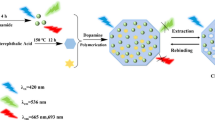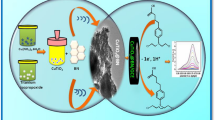Abstract
A composite film of DNA/poly(3-methylthiophene) (P3MT) modified glassy carbon electrode (GCE) has been fabricated by electro-deposition method. P3MT film was first electropolymerized at the GCE and the DNA layer was then immobilized on the P3MT layer by electrochemical method. The voltammetric behavior of 8-hydroxy-2′-deoxyguanosine (8-OH-dG) at the composite film modified electrode was studied. The effects of scan rates, pH and the interference of uric acid (UA) on the voltammetric behavior and detection of 8-OH-dG were also discussed. The experimental results suggest that the electrochemical behavior of 8-OH-dG at the composite film modified electrode was greatly improved due to the combination of the advantages of P3MT and DNA. In 0.1 M pH 7.0 phosphate buffer solution (PBS), the anodic peak currents of 8-OH-dG were linear with the 8-OH-dG concentration in two intervals, viz. 0.28–4.2 µM and 4.2–19.6 µM. The detection limit of 56 nM 8-OH-dG could be estimated (S/N = 3). This proposed composite film modified electrode shows excellent reproducibility and stability. It may have the potential application for the detection of 8-OH-dG in human urine.
Similar content being viewed by others

References
Boon E M, Barton J K. Charge transport in DNA. Curr Opin Struck Biol, 2002, 12: 320–329
Delaney S, Barton J K. Long-range DNA charge transport. J Org Chem, 2003, 68(17): 6475–6483
O’Neill M A, Barton J K. DNA charge transport: Conformationally gated hopping through stacked domains. J Am Chem Soc, 2004, 126(37): 11471–11483
O’Neill M A, Barton J K. DNA-mediated charge transport requires conformational motion of the DNA bases: Elimination of charge transport in rigid glasses at 77 K. J Am Chem Soc, 2004, 126(41): 13234–13235
Delaney S, Barton J K. Charge transport in DNA duplex/quadruplex conjugates. Biochem, 2003, 42(48): 14159–14165
Williams T T, Odom D T, Barton J K. Variations in DNA charge transport with nucleotide composition and sequence. J Am Chem Soc, 2000, 122(37): 9048–9049
Lakhno V D, Sultanov V B, Pettitt B M. Combined hopping-superexchange model of a hole transfer in DNA. Chem Phys Lett, 2004, 400(1–3): 47–53
Jiang X H, Lin X Q. Atomic force microscopy of DNA self-assembled on a highly oriented pyrolytic graphite electrode surface. Electrochem Commun, 2004, 6(9): 873–879
Lin X Q, Jiang X H, Lu L P. DNA nano-netting intertexture on carbon electrodes. Chin Chem Lett, 2004, 15(8): 997–1000
Lin X Q, Jiang X H, Lu L P. DNA deposition on carbon electrodes under controlled DC potentials. Biosens Bioelectron, 2005, 20(9): 1709–1717
Su X D. Covalent DNA immobilization on polymer-shielded silver-coated quartz crystal microbalance using photobiotin-based UV irradiation. Biochem Biophys Res Commun, 2000, 290(3): 962–966
Wang J, Jiang M. Toward genolelectronics: Nucleic acid doped conducting polymers. Langmuir, 2000, 16(5): 2269–2274
Gibbs J M, Park S J, Anderson D R, Watson K J, Mirkin C A, Nguyen S B T. Polymer-DNA composites as electrochemical probes for the detection of DNA. J Am Chem Soc, 2005, 127(4): 1170–1178
Lassalle N, Mailley P, Vieil E, Livache T, Roget A, Correia J P, Abrantes L M. Electronically conductive polymer grafted with oligonucleotides as electrosensors of DNA preliminary study of real time monitoring by in situ techniques. J Electroanal Chem, 2001, 509(1): 48–57
Wang J, Jiang M, Fortes A, Mukherjee B. New label-free DNA recognition based on doping nucleic-acid probes within conducting polymer films. Anal Chim Acta, 1999, 402(1–2): 7–12
Jiang M, Wang J. Recognition and detection of oligonucleotides in the presence of chromosomal DNA based on entrapment within conducting polymer networks. J Electroanal Chem, 2001, 500(1–2): 584–589
Franceschi S, Bordeau O, Millerioux C, Perez E, Vicendo P, Rico-Lattes I, Moisand A. Highly compacted DNA-polymer complexes obtained via new polynorbornene polycationic latexes with lactobionate counterion. Langmuir, 2002, 18(5): 1743–1747
Cha J, Han J I, Choi Y, Yoon D S, Oh K W, Lim G. DNA hybridization electrochemical sensor using conducting polymer. Biosens Bioelectron, 2003, 18(10): 1241–1247
Minehan D S, Marx K A, Tripathy S K. Kinetics of DNA binding to electrically conducting polypyrrole films. Macromolecules, 1994, 27(3): 777–783
Thompson L A, Kowalik J, Josowicz M, Janata J. Label-free DNA compositeization probe based on a conducting polymer. J Am Chem Soc, 2003, 125(2): 324–325
Li T H, Jia W L, Wang H S, Liu R M. Electrochemical performance of 8-hydroxy-2′-deoxyguanosine and its detection at poly(3-methylthiophene) modified glassy carbon electrode. Biosens Bioelectron, 2007, 22(7): 1245–1250
Shigenaga M A, Ames B N. Assay for 8-hydroxy-2′-deoxyguanosine: A biomarker of in vivo oxidatve DNA damage. Free Radic Biol Med, 1991, 10(3–4): 211–216
Floyd R A, Watson J J, Wong P K, Altmiller D H, Rickard R C. Hydroxyl free radical adduct of deoxyguanosine: Sensitive detection and mechanisms of formation. Free Radic Res Commun, 1986, 1(3): 163–172
Kasai H. Analysis of a form of oxidative DNA damage, 8-hydroxy-2′-deoxyguanosine, as a marker of cellular oxidative stress during carcinogenesis. Mutat Res, 1997, 387(3): 147–163
Toraason M. 8-Hydroxydeoxyguanosine as a biomarker of workplace exposures. Biomarkers, 1999, 4(1): 3–26
Li C S, Wu K Y, Chang-Chien G P, Chou C C. Analysis of oxidative DNA damage 8-hydroxy-2′-deoxyguanosine as a biomarker of exposures to persistent pollutants for marine mammals. Environ Sci Technol, 2005, 39(8): 2455–2460
La D K, Swenberg J A. DNA adducts: Biological markers of exposure and potential applications to risk assessment. Mutat Res, 1996, 365(1–3): 129–146
Fraga C G, Shigenaga M K, Park J W, Degan P, Ames B N. Oxidative damage to DNA during aging: 8-hydroxy-2′-deoxyguanosine in rat organ DNA and urine. Proc Natl Acad Sci USA, 1990, 87(12): 4533–4537
Shimoda R, Nagashima M, Sakamoto M, Yamaguchi N, Hirohashi S, Yokota J, Kasai H. Increased formation of oxidative DNA damage, 8-hydroxydeoxy-guanosine, in human livers with chronic hepatitis. Cancer Res, 1994, 54: 3171–3172
Asami S, Manabe H, Miyake J, Tsurudome Y, Hirano T, Yamaguchi R, Itoh H, Kasai H. Cigarette smoking induces an increase in oxidative DNA damage, 8-hydroxydioxyguanisine, in a central site of the human lung. Carcinogenesis, 1997, 18(9): 1763–1766
Foksinski M, Kotzbach R, Szymanski W, Olinski R. The level of typical biomarker of oxidative stress 8-hydroxy-2′-deoxyguanosine is higher in uterine myomas than in control tissues and correlates with the size of the tumor. Free Rad Biol Med, 2000, 29(7): 597–601
Kuo H W, Chou S Y, Hu T W, Wu F Y, Chen D J. Urinary 8-hydroxy-2′-deoxyguanosine (8-OH-dG) and genetic polymorphisms in breast cancer patients. Mutat Res, 2007, 631(1): 62–68
Suzuki H, Inoue Y, Suzuk I S. Changes in the urinary excretion level of 8-hydroxyguanine by exposure to reactive oxygen-generating substances. Free Rad Biol Med, 1995, 18(3): 431–436
Loft S, Vistisen K, Ewertz M, Tjønneland A, Overvad K, Poulsen H. Oxidative DNA damage estimated by 8-hydroxy-deoxyguanosine excretion in humans: influence of smoking, gender and body mass index. Carcinogenesis, 1992, 13(12): 2241–2247
Wang J, Li R L. Highly stable voltammetric measurements of phenolic compounds at poly(3-methylthiophene) coated glassy carbon electrode. Anal Chem, 1989, 61(24): 2809–2811
Wang H S, Huang D Q, Liu R M. Study on the electrochemical behavior of epinephrine at a poly(3-methylthiophene) modified glassy carbon electrode. J Electroanal Chem, 2004, 570(1): 83–90
Lu L P, Lin X Q. Glassy carbon electrode modified with gold nanoparticles and DNA for the simultaneous determination of uric acid and norepinephrine under coexistence of ascorbic acid. Anal Sci, 2004, 20(3): 527–530
Langmaier J, Samec Z, Samcová E. Electrochemical oxidation of 8-Oxo-2′-deoxyguanosine on glassy carbon, gold, platinum and Tin(IV) oxide electrodes. Electroanalysis, 2003, 15(19): 1555–1560
Laviron E. General expression of the linear potential sweep voltammogram in the case of diffusionless electrochemical systems. J Electroanal Chem, 1979, 101(1): 19–28
Goyal R N, Jain N, Garg D K. Electrochemical and enzymic oxidation of guanosine and 8-hydroxyguanosine and the effects of oxidation products in mice. Bioelectrochem Bioenerge, 1997, 43(1): 105–114
Bessho T, Tano K, Kasai H, Ohtsuka E, Nishimura S. Evidence for two DNA repair enzymes for 8-hydroxyguanine (7,8-dihydro-8-oxoguanine) in human cells. J Biol Chem, 1993, 268(26): 19416–19421
Rebelo I, Piedade J A P, Oliveira A M Brett. Electrochemical determination of 8-oxoguanine in the presence of uric acid. Bioelectrochem, 2004, 63(1–2): 267–270
Author information
Authors and Affiliations
Corresponding author
Additional information
Supported by the National Natural Science Foundation of China (Grant Nos. 20475024 & 20775031) and the Shandong Tai-Shan Scholar Research Fund
Rights and permissions
About this article
Cite this article
Wang, Y., Li, J., Liu, Y. et al. Fabrication of the DNA/poly(3-methylthiophene) composite film modified electrode and its application for the study on the voltammetric behavior and determination of 8-hydroxy-2′-deoxyguanosine. Sci. China Ser. B-Chem. 52, 2006–2012 (2009). https://doi.org/10.1007/s11426-009-0241-6
Received:
Accepted:
Published:
Issue Date:
DOI: https://doi.org/10.1007/s11426-009-0241-6



